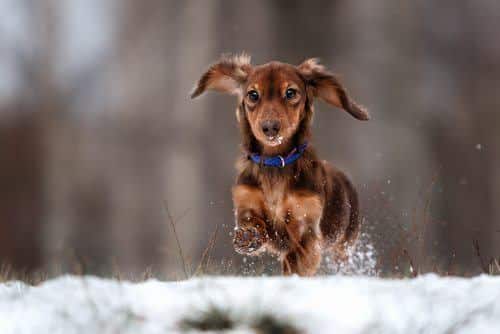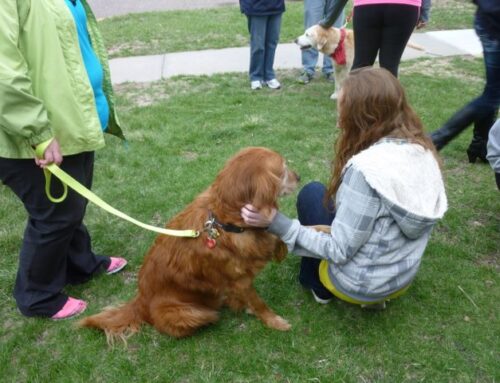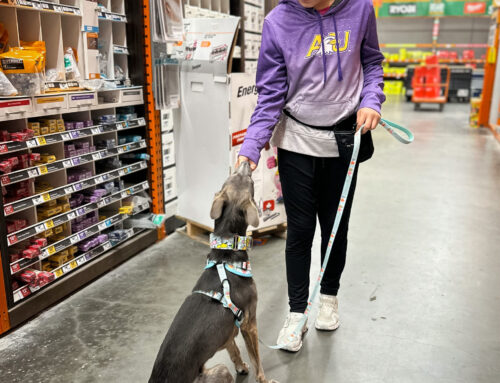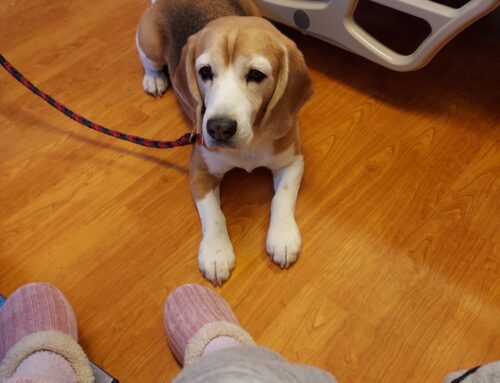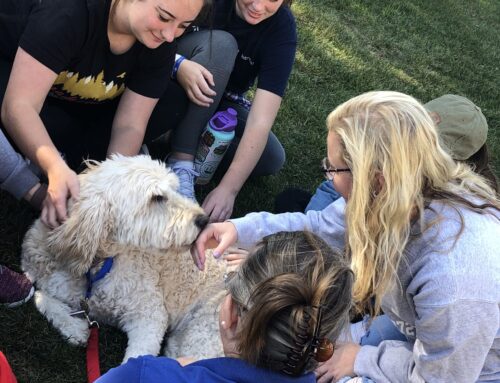As the premier therapy dog organization in the United States, the staff at Alliance of Therapy Dogs want to make sure that everyone knows the ways in which you can keep your dog safe during the winter months. Some dog owners believe that because their pets have a coat of fur, they can tolerate the cold better than humans; this is not always the case. Like us, dogs are used to the warmth of the indoors and cold weather can be as hard on them as it is on us. Winter is a time when our dogs need a little extra care. In this article, we will explain the winter health risks to your dog and suggestions to keep your best friend safe this winter.
How Can I Prevent Winter Health Risks to My Dog?
The two most serious risks for dogs during the winter are frostbite and hypothermia.
Frostbite. Frostbite begins when the dog’s body gets cold. The body pulls blood from the extremities to the center of the body to stay warm. The dog’s ears, paws or tail can get so cold that ice crystals will form in the tissue and damage it. Frostbite is not immediately obvious. Watch for signs of pale or grey skin as the skin may also turn hard and cold. As frostbitten areas warm, they can be extremely painful. Severely frostbitten skin will eventually turn black and fall off.
Hypothermia. The other very serious winter weather health concern for dogs is hypothermia. Hypothermia occurs when a dog spends too much time in the cold, gets wet in cold temperatures or when dogs with poor health or circulation are exposed to cold. In mild cases, the dog will shiver and ears and feet will become cold. As hypothermia progresses, your dog may show signs of depression, lethargy, and weakness. As the condition worsens, the muscles will stiffen, the heart and breathing rates slow down, and will not respond to stimuli. Severe hypothermia is life-threatening.
What Are the Ways in Which I Can Help Protect My Dog During the Winter Months?
Temperature. Some dog breeds are blessed with thick fur that keeps them warm naturally in very cold temperatures, but dogs with thin coats may need to wear a sweater or coat when out for winter walks. A good coat should reach from the neck to the base of the tail and also protect the belly but coats will not prevent frostbite on the ears, feet or tail. Even wearing a warm coat, do not keep your short-haired dog out for too long in freezing temperatures.
Go outside when the sun shines. Try to walk your dog in the late morning or early afternoon hours when temperatures are a little warmer, and avoid early morning or late evening walks. Spend time playing outdoors while it is sunny; sunshine brings the added benefit of providing both you and your pet with vitamin D. Play fetch with toys, not sticks, as sticks can cause choking and other injuries. If your dog wants to chew and chase, bring a Frisbee, ball or other safe toy and play together in the sun.
Indoor pets are happiest. Our family dog needs to be indoors with us. Take your dog out frequently for walks and exercise but your dog should live inside the home. Do not leave pets outdoors alone when the temperature drops. A good rule of thumb is to go out with them and when you are ready to come in, your dog probably is, too.
Warm bedding. Do not let your best friend sleep on a cold floor in winter. Choosing the right bedding is essential to ensure your dog stays warm. Warm blankets can create a snug environment. Elevated beds will keep your dog off cold tiles or concrete, and heated pet beds can help keep the stiffness out of aging joints. Place your dog’s bed in a warm spot away from drafts, cold tile or uncarpeted floors, preferably in a favorite spot where he sleeps every day so that the area does not feel unfamiliar.
Keep your dog away from heat sources. Dogs will often seek heat during cold winter weather by snuggling too close to heating sources. Avoid space heaters and be mindful of fireplaces. Never leave pets alone near a fireplace or wood stove. Even if your fireplace has a mesh covering or glass doors, pets can still get burns from coming into contact with those hot surfaces.
Moisturize.Your home’s furnace or central air system emits dry heat. This low humidity environment can rob your dog’s skin of necessary moisture, which results in dry, flaky, and sensitive skin. while it is true that your dog’s body continually replaces the layer of damaged skin, however, if left unmanaged, the condition will continue throughout the winter. Damaged skin and your dog’s relentless scratching to relieve her itch can open the door for more serious skin problems.
Do not overfeed. Although dogs may need an extra layer in winter, it should come from the coat and not a layer of fat. Cold temperatures may even bring on lazy behavior and the need for fewer calories. Be attentive to your dog’s activity level and adjust his calories accordingly. A high quality, whole foods, preferably meat-based diet will help ensure a healthy coat and good energy for the cold winter months.
Paw care. Dogs can also suffer from cracked pads just as we can suffer from cracked feet during the winter months. If your dog has furry feet, trim the hair that grows between his pads to prevent ice buildup between the pads. Winter salt on city sidewalks can also burn your dog’s pads and is toxic, so after walks around the neighborhood, rinse or wipe your dog’s paws to remove any salt. If your dog shows signs of discomfort when walking outside on frozen or salted surfaces, consider using dog booties to protect his paws.
Snow removal. Snow can be dangerous for your dog. Snow piled near fences offers your dog escape routes that even well-trained dogs often cannot resist. After clearing snow from your yard, pile it away from fences to prevent your dog from climbing over. Snow and ice often accumulate on rooftops and if the sun is out or as temperatures rise, this accumulation can slide and injure your dog. If you cannot clear the snow from the roof, keep your dog away from the roof overhang to prevent injury.
Never leave your dog unattended in the car, no matter the season. Just as cars can get dangerously hot in summer, freezing cold temperatures are equally dangerous for your dog in winter. Leaving the car running involves additional risks, including carbon monoxide poisoning if the car is parked in a garage. It is best to leave your dog at home when you go out to run errands.
Special care for seniors. Cold weather will often aggravate existing medical conditions in dogs, particularly arthritis. It is very important to maintain an exercise routine with your arthritic dog, but be mindful of slippery surfaces and make sure that your dog has a warm soft rest area to recuperate after activity. If you do not already give your senior dog a natural joint supplement to lubricate the joints and ease the discomfort of arthritis, you may want to talk to your vet about adding glucosamine and chondroitin to your dog’s senior diet.
Harsh winter weather brings a wide variety of concerns to responsible dog owners. Bitter cold, numbing wetness or biting winds can cause discomfort for your dog. As one of the family, it is important to keep your dog warm, dry and healthy during the winter months. Should you have questions about providing extra care for your dog this winter, contact the Alliance of Therapy Dogs.

